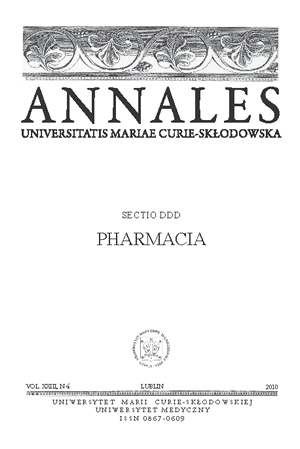Bacterial genera/species isolated from blood cultures in the university hospital microbiology unit
Keywords:
blood cultures, coagulase-negative staphylococci, Staphylococcus epidermidisAbstract
Blood cultures are one of the most important microbiological procedures performed in the hospitalized patients. In this paper an analysis concerning the prevalence of various groups of microorganisms isolated from blood cultures in the university hospital in Lublin was presented. From 180 positive blood culture samples, 106 (59.22%) isolates of Gram-positive bacteria and 73 (40.78%) isolates of Gram-negative bacteria were obtained. Among Gram-positive bacteria, 75 (70.76%) belonged to staphylococci, 15 (14.15%) – to enterococci and 13 (12.26%) – to streptococci. Among staphylococci, coagulase-negative staphylococci predominated – 63 (84.0%) isolates, while the most frequently isolated species was Staphylococcus epidermidis – 61 (81.34%) isolates. Our data are in agreement with the general statement that S. epidermidis can be still regarded as an important etiological agent of bloodstream infections.
References
1. Banerjee S.N. et al.: Secular trends in nosocomial primary bloodstream infections in the United States, 1980-1989. National Nosocomial Infections Surveillance System. Am. J. Med., 91, 86S, 1991.
2. Edmond M.B.: Nosocomial bloodstream infections in United States hospitals: a 3-year analysis. Clin. Infect. Dis., 29, 239, 1999.
3. Emory T.G., Gaynes R.P.: An overview of nosocomial infections, including the role of the microbiology laboratory. Clin. Microbiol. Rev., 6, 428, 1993.
4. Karchmer A.W.: Nosocomial bloodstream infections: organisms, risk factors and implications. Clin. Infect. Dis., 31, S139, 2000.
5. McCann M.T. et al.: Staphylococcus epidermidis device-related infections: pathogenesis and clinical management. J. Pharm. Pharmacol., 60, 1551, 2008.
6. Natoli S. et al.: Characterization of coagulase-negative staphylococci isolates from blood with reduced susceptibility to glycopeptides and therapeutic options. BMC Infect Dis., 2009 [http://www.biomedcentral.com/content/pdf/1471-2334-9-83.pdf].
7. Pittet D., Wenzel R.P.: Nosocomial bloodstream infections. Arch. Intern. Med., 155, 1177,1995.
8. Schaberg D.R. et al.: Major trends in the microbial etiology of nosocomial infection. Am. J. Med., 91, 72S, 1991.
9. Taylor G. et al.: Long term trends in the occurrence of nosocomial blood stream infection. Can J. Infect. Dis., 11, 29, 2000.
10. Towns M.L. et al.: Guidelines on blood cultures. J. Microbiol. Immunol. Infect., 43, 347, 2010.
11. Weinstein M.P. et al.: The clinical significance of positive blood cultures in the 1990s: a prospective comprehensive evaluation of the microbiology, epidemiology and outcome of bacteremia and fungemia in adults. Clin. Infect. Dis., 24, 584, 1997.
Downloads
Published
Issue
Section
License
Copyright (c) 2010 Authors

This work is licensed under a Creative Commons Attribution-NonCommercial-NoDerivatives 3.0 Unported License.


